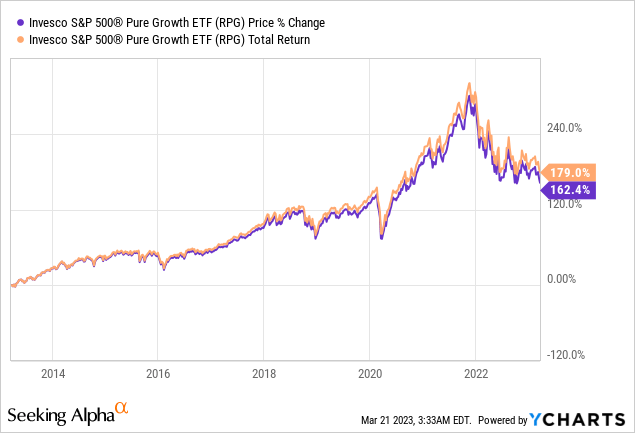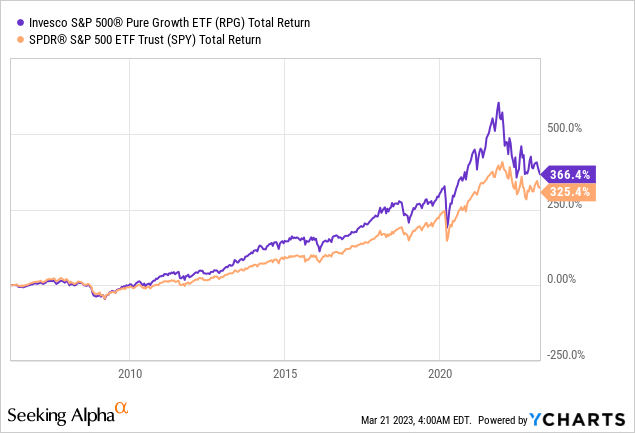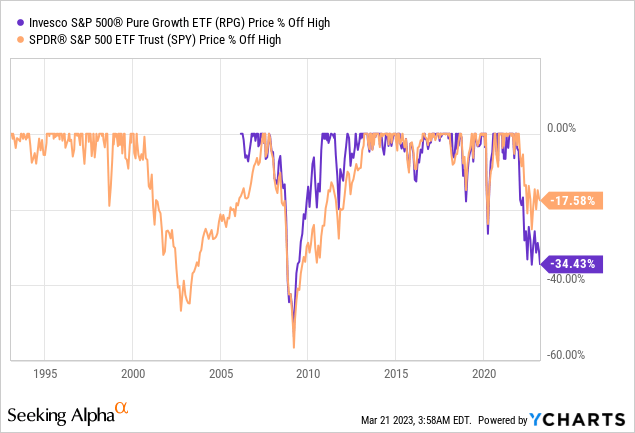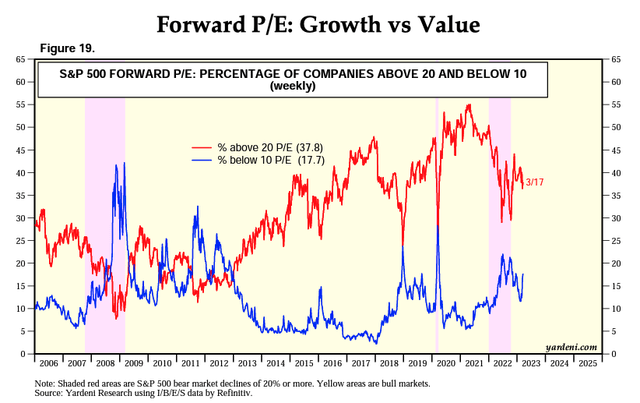RPG: Valuation Is Still High Vs. The Historical Range

Summary
- RPG invests in U.S. large-cap growth stocks in the S&P 500 Index.
- The fund has outperformed the broader market in the long run thanks to its strong growth characteristic in its portfolio.
- Despite last year's bear market decline, RPG’s valuation is still towards the high end of the historical range.
AlexSecret
ETF Overview
Growth stocks have encountered heavy casualties since early 2022 due to the Federal Reserve's effort to tame inflation. Will growth stock turn around this year or will they continue to slide? In this article, we will analyze Invesco S&P 500 Pure Growth ETF (NYSEARCA:RPG), a fund that invests in U.S. large-cap growth stocks in the S&P 500 index, and provide our insights and suggestions.
RPG ETF has strong growth characteristics than the broader S&P 500 index and has therefore outperformed the index in the long run. Although the fund has experienced significant decline since early 2022, its valuation is still quite elevated when compared to the historical average. Therefore, we think investors should patiently wait for a better entry point.
YCharts
Fund Analysis
RPG has outperformed the broader market in the long run
The year 2022 was an abysmal year for RPG and many other growth stocks. In fact, the fund has declined by over 31% since early January. This is much worse than the S&P 500 index which declined by only about 17%. This underperformance was likely because many growth stocks have outperformed the broader market significantly during the pandemic. Therefore, they endured much larger degree of multiple compression than the broader market.
Despite this significant decline in the past year, RPG still delivered strong total returns in the long run. As can be seen from the chart below, RPG's total return of 366.4% was better than the 325.4% return of the SPDR S&P 500 ETF (SPY), which tracks the S&P 500 index. This better return in the long run was primarily due to its portfolio selection methodology that resulted in a portfolio that exhibit growth characteristic.
YCharts
However, downside risk is similar to the broader market
Other than its recent underperformance, RPG has similar downside risk to the broader market historically. As can be seen from the chart below, RPG declined by about 55% and 27% in 2008/2009 and 2020 recessions respectively. These declines were comparable to the S&P 500's decline.
YCharts
RPG's valuation is still elevated
Let us now examine the valuation of RPG to see if it's current valuation is attractive or not. As can be seen from the chart below, growth stocks in the S&P 500 currently have an average forward P/E ratio of 19.2x. Although this ratio is now significantly lower from the cyclical high of nearly 30x reached between 2020 and 2021, it is still quite elevated compared to its historical range in the past 15 years. Between 2010 and 2020, growth stocks have usually traded in the range of 15x and 20x. Therefore, the current average forward P/E ratio of 19.2x is still towards the high end of this range. Therefore, we think growth stocks in the S&P 500 index are generally still overvalued.
Valuation still needs to compress further
Let us now look at another interesting indicator. This indicator tracks the percentage of stocks that have forward P/E ratios above 20x and percentage of stocks that have forward P/E ratio below 10x since 2006. As can be seen from the chart, the stock market bottom is usually reached when the percentage of companies above 20x and below 10x diverge. These occasions occurred in 2008/2009, 2018/2019, and 2020. Currently, the percentage of companies that have forward P/E ratios above 20x is in a declining trend. On the other hand, the percentage of companies that have forward P/E ratios below 10x is in a rising trend. However, they have not diverged yet. Therefore, we think the timing is still not right. Investors should wait for a better entry point.
Investor Takeaway
Since the Federal Reserve may continue to keep the rate "higher and longer" to combat persistent inflation, its monetary policy will inevitably tip the economy over to a recession. Therefore, uncertainty is very high in 2023. Given RPG's still elevated valuation, investors may want to wait patiently on the sidelines.
This article was written by
Disclosure: I/we have no stock, option or similar derivative position in any of the companies mentioned, and no plans to initiate any such positions within the next 72 hours. I wrote this article myself, and it expresses my own opinions. I am not receiving compensation for it (other than from Seeking Alpha). I have no business relationship with any company whose stock is mentioned in this article.
Additional disclosure: Additional Disclosure: This is not financial advice and that all financial investments carry risks. Investors are expected to seek financial advice from professionals before making any investment.


